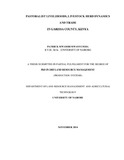| dc.description.abstract | In the arid and semi-arid areas of northeastern Kenya, pastoralists are facing increasing risks
such as drought, insecurity, animal diseases, increasing human populations and land
fragmentation. These, together with subsistence and market demands, influence households‟
characteristics and how they interact with livestock resources at their disposal to meet
livelihood objectives. Livestock trade plays a key role in local food security and poverty
alleviation. It also has poorly understood implications on indigenous animal genetics
utilization; conservation; importation of „exotic‟ genetics; and transmission of trans-boundary
diseases. This study was done in Garissa county to analyze current pastoralist sociodemographics,
production objectives and livelihoods strategies; to evaluate livestock herd
dynamics and reproduction; and to analyze the county livestock market and destinations of
marketed livestock. The study was done using a cross-sectional survey of 146 households and
by observation of the market functions, interviews with market players and longitudinal
recording of sales and purchases. Livestock were the main source of income for 93% of
households though 35% of households had plans to diversify. Most households were
sedentary (68.5%), moving their livestock only at times of drought. Most households‟
members had low levels of education and provided 57% of the grazing labour. The mobile
phone was a significant means of getting reports of distant livestock, second to owner visits.
Goats provided most of the milk and market animals at 49% and 46% respectively.
Households last sold their livestock a mean of 72 days before the interview date. Constraints
cited arose from droughts, movement, livestock diseases and in marketing. Most households
combined traditional strategies with relief aid to cope with these constraints. Within livestock
herds, reproductive age females formed over 50% of all species. Livestock were not even
cattle, sheep and goats respectively. All species had a 12 months negative balance with 58%
exits and 42% entries. Cows calved first at four years and lived up to a maximum of 22 years,
but the mean age of reproductive animals was 8 years. There were many (62%) cow
pregnancies after the rains and abortions were rare. In the livestock market, incoming animal
consignments were 71% local, 29% cross-border and 75% on foot. Local consignments
accounted for 54%, 38% and 87% of all animals, cattle and camels respectively and all the
small stock. Somalia contributed 46%, 65% and 14% of all animals, cattle and camels
respectively. Over 85% of the purchased animals were trucked to long distance destinations
for slaughter, fattening and breeding. The market concentration ratio was 24% and 10% for
sales and purchases respectively. The market value of the animals passed on to the producers
was 86% and the wholesale margin was 17% comprising of 8% marketing costs and 92%
profit. It was concluded that livestock herds were resilient, structured to provide milk and
reproduce reasonably well. The market facilities were not adequate for livestock disease
control, human and animal welfare and general hygiene, but business was competitive. It is
recommended that participatory interventions to support local animal productivity,
diversification and market facilities be set-up and households should balance between
livestock labour and education needs of their dependants.
Key words: demographic parameters, livestock distribution and equity, livestock cycles,
livestock inventory, livestock market competitiveness. | en_US |

